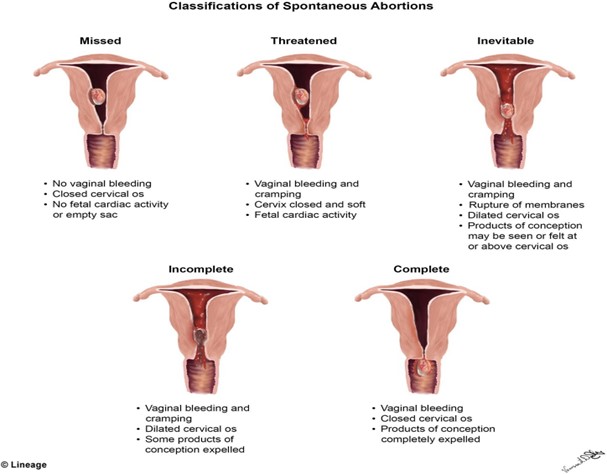A woman presents to the emergency department complaining of bleeding and cramping. The initial history is significant for a last menstrual period 6 weeks ago. On sterile speculum examination, the care provider finds that the cervix is closed. The anticipated plan of care for this woman would be based on a probable diagnosis of which type of spontaneous abortion?
Threatened
Inevitable
Missed
Incomplete
The Correct Answer is A
Based on the provided information, the probable diagnosis for the spontaneous abortion in this woman would be a threatened abortion, since the cervix is closed and there is no evidence of expulsion of fetal or placental tissue. A threatened abortion is defined as vaginal bleeding occurring before the 20th week of gestation, with a closed cervical os, and no expulsion of fetal or placental tissue.
The other types of spontaneous abortion are defined as follows:
B. Inevitable abortion: vaginal bleeding and cramping with an open cervical os, with or without expulsion of fetal or placental tissue
C. Missed abortion: fetal demise without expulsion of fetal tissue, and may be associated with a closed cervical os and absence of uterine contractions
D. Incomplete abortion: partial expulsion of fetal or placental tissue, with or without vaginal bleeding, and may be associated with an open cervical os and uterine contractions

Nursing Test Bank
Naxlex Comprehensive Predictor Exams
Related Questions
Correct Answer is C
Explanation
Health literacy is defined as the degree to which an individual can obtain, process, and
understand basic health information and services needed to make appropriate health decisions. Basic functional health literacy refers to an individual's ability to read and understand simple health information and instructions.
While all the clients mentioned may be demonstrating health literacy, the ability to read and understand discharge instructions after routine surgery is a basic functional health literacy skill. This client is able to comprehend written health information and follow simple instructions, which is an important aspect of managing their own health care.
The other clients mentioned may be displaying a higher level of health literacy, such as the client who is teaching a class about cancer survival or the client with Type II Diabetes who is using nutritional information to make a grocery list. These individuals may have a greater ability to understand and apply complex health information and navigate the healthcare system.
Correct Answer is A
Explanation

Whether you are a student looking to ace your exams or a practicing nurse seeking to enhance your expertise , our nursing education contents will empower you with the confidence and competence to make a difference in the lives of patients and become a respected leader in the healthcare field.
Visit Naxlex, invest in your future and unlock endless possibilities with our unparalleled nursing education contents today
Report Wrong Answer on the Current Question
Do you disagree with the answer? If yes, what is your expected answer? Explain.
Kindly be descriptive with the issue you are facing.
